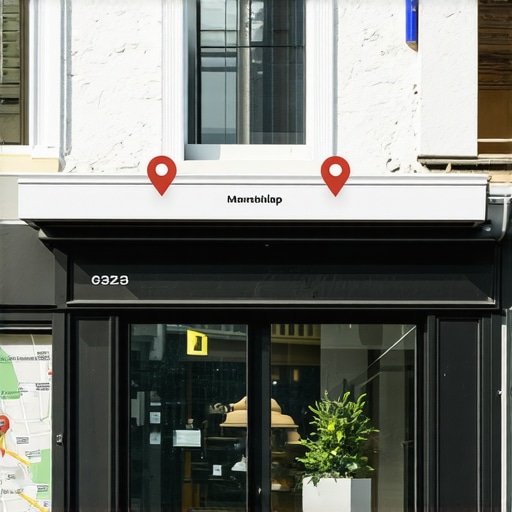My Personal Journey into the World of Google Maps Optimization
It all started when I realized how crucial local visibility is for small businesses. I remember the first time I tried to optimize a Google My Business (GMB) profile for a local coffee shop. Despite my efforts, the business struggled to appear on the map, and I felt frustrated. That experience sparked my curiosity and led me down the path of mastering local SEO and GMB optimization.
Understanding the Power of GMB for Local Businesses
Through trial and error, I learned that a well-optimized GMB profile can dramatically boost a business’s visibility. I read authoritative sources like Help Me Rank GMB’s guide and discovered that factors like accurate NAP information, engaging photos, and positive reviews are vital for ranking higher in local searches.
My Strategies for Effective GMB Optimization
One of my key insights was that consistency is king. Ensuring that business name, address, and phone number (NAP) are uniform across all platforms prevents confusion and boosts trustworthiness. I also started focusing on local keywords naturally integrated into the business description, which helped improve relevance in Google Maps. Regularly updating the profile with fresh posts and responding to reviews created more engagement and showed Google that the listing was active.
How to Outrank Competitors: Is It Possible?
What innovative techniques can help you outrank your competitors on Google Maps?
Absolutely! I experimented with adding high-quality images, leveraging customer reviews, and using Google My Business insights to refine my approach. According to Help Me Rank’s advanced support strategies, leveraging data and insights is crucial for sustained success. Combining these tactics with local SEO best practices can give you a real edge.
If you’re serious about dominating local search, don’t underestimate the power of consistent, targeted efforts. I’ve seen firsthand how these strategies can transform a business’s online presence.
Sharing My Experience: Have You Tried These Techniques?
I invite you to share your experiences or ask questions about GMB optimization in the comments. Remember, the landscape is always evolving, so staying informed through trusted resources is key. For in-depth guidance, I recommend exploring this comprehensive guide on local SEO strategies.
Unlocking the Secrets: How Can Local SEO and GMB Optimization Drive Your Business to the Top?
As an SEO expert, I often encounter businesses struggling to stand out in local searches despite investing in basic GMB setup. The reality is, mastering advanced strategies can significantly elevate your visibility and outrank competitors. One crucial aspect is leveraging Google My Business insights effectively. By analyzing customer behavior and engagement metrics, you can identify what drives conversions and tailor your profile to meet those needs. This targeted approach aligns with advice from Help Me Rank’s advanced GMB tactics, emphasizing data-driven optimization.
What innovative methods can you implement to stay ahead in Google Maps rankings?
Beyond basic optimization, consider integrating local multimedia content such as 360-degree virtual tours, behind-the-scenes videos, and customer testimonials. These elements not only enhance user engagement but also signal activity to Google’s algorithm, increasing your chances of climbing the ranks. Additionally, establishing local backlinks from reputable community websites and local news outlets can significantly boost your authority and relevance in Google Maps. Ensuring your NAP consistency across all online directories, including niche industry sites, further solidifies your local presence.
Furthermore, actively managing your online reputation through prompt review responses and encouraging satisfied customers to leave detailed feedback can create a positive feedback loop that supports higher rankings. As noted by Help Me Rank’s SEO support insights, reputation signals are a pivotal ranking factor.
< >
>
How does Google’s evolving algorithm impact your local SEO strategy?
Google continuously updates its local search algorithm to prioritize relevance, proximity, and authoritative signals. This means that a static approach to GMB optimization is no longer sufficient. Staying informed about algorithm changes—such as the recent emphasis on user experience and engagement metrics—can help you adapt your tactics proactively. For instance, implementing structured data markup on your website can improve how Google understands your business details, reinforcing your profile’s credibility. To navigate this complex landscape, I recommend regularly consulting authoritative resources like this comprehensive local SEO guide.
Are you actively monitoring your GMB insights and adjusting your strategy accordingly? If not, now is the perfect time to start refining your approach to stay ahead in the competitive local search arena. Remember, consistent effort and strategic innovation are your best tools for sustained success.
If you found these insights helpful, consider sharing your experiences or asking questions in the comments. For more expert tips on boosting your local visibility, explore this detailed guide on proven local SEO strategies.
Refining Your Approach: The Nuances of Local SEO in a Competitive Landscape
As I delved deeper into the intricacies of Google Maps optimization, I realized that success hinges not just on implementing basic tactics but on understanding the subtle signals that influence rankings. For instance, I started experimenting with Google My Business attributes—adding specific service options, highlighting unique selling points, and leveraging the platform’s new features introduced in 2024. These seemingly minor details can significantly impact relevance and visibility, especially when competitors overlook them.
How Can Advanced Data-Driven Techniques Elevate Your Local SEO?
One game-changing realization was the importance of harnessing data analytics to inform your strategy. Using tools like Google Insights, I identified patterns in customer engagement, peak activity times, and popular search queries. This granular data allowed me to tailor my content and engagement efforts—such as posting during high-traffic periods or emphasizing services that resonate most with local search intent. According to Help Me Rank’s advanced support tactics, this level of precision can be a decisive factor in outranking competitors.
What Role Does Local Content and Community Engagement Play in Sustained Top Rankings?
Beyond technical optimization, I discovered that active community engagement and local content creation are vital. Sharing stories about local events, collaborations, or customer success stories not only boosts engagement but also signals to Google that your business is a vital part of the community. I started hosting local webinars and participating in neighborhood forums, which organically generated backlinks and reviews—key factors in Google’s local algorithm. These efforts foster trust and establish your brand as a local authority, making it harder for competitors to displace you.
How Does Google’s Evolving Algorithm Shape Long-Term SEO Strategies?
Google’s algorithms are increasingly sophisticated, prioritizing user experience, trustworthiness, and engagement. I learned that staying ahead requires continuous adaptation—such as optimizing for voice search, implementing structured data markup, and ensuring your website provides a seamless mobile experience. Regularly auditing your GMB profile and website with the latest SEO insights ensures you don’t fall behind. For example, recent updates have placed more emphasis on the quality and freshness of content, making ongoing updates and reputation management even more critical. To stay informed, I rely heavily on trusted resources like this comprehensive local SEO guide.
Have you integrated these advanced techniques into your strategy yet? If not, now is the perfect time to start experimenting and sharing your results. The landscape is dynamic, and those who adapt quickly will enjoy sustained visibility and growth.
Engage and Share Your Experiences
I invite fellow entrepreneurs and SEO enthusiasts to share their insights or ask questions about these advanced strategies. Together, we can navigate the complexities of Google Maps rankings and uncover new opportunities for local dominance. Remember, continuous learning and adaptation are your best tools for long-term success in local SEO. For further tips, don’t hesitate to explore this detailed guide on proven local SEO strategies.
Leveraging Artificial Intelligence for Hyper-Localized Optimization
One of the most transformative developments in the realm of local SEO is the integration of artificial intelligence (AI). By utilizing AI-powered tools, I have been able to analyze vast amounts of local search data to identify emerging trends and subtle ranking signals that human analysis might overlook. For instance, AI platforms can process reviews, engagement metrics, and even competitors’ strategies in real-time, providing actionable insights that inform my optimization tactics. According to Help Me Rank, implementing AI-driven analytics is now essential for staying ahead in the competitive local landscape.
Crafting Micro-Content to Boost Engagement and Relevance
Beyond traditional posts and photos, I found that creating micro-content—such as quick tips, localized trivia, or mini customer success stories—can significantly enhance user engagement and signal activity to Google. These bite-sized pieces of content often resonate more with local audiences, encouraging shares and reviews. For example, I regularly share seasonal offers or local event highlights through short videos or infographics. This approach not only increases visibility but also fosters a sense of community around the brand, which Google increasingly values in its ranking algorithms.
Implementing Schema Markup for Business Attributes
One of the more technical yet impactful strategies I adopted involves the use of schema markup on my website. Structured data helps search engines better understand your business details, such as service offerings, operating hours, and location-specific attributes. This enhanced understanding can improve your visibility in local packs and rich snippets. Google’s recent updates, as detailed in this comprehensive guide, emphasize the importance of technical SEO elements like schema in maintaining and improving rankings.
How Can Integrating Voice Search Optimization Transform Your Local SEO Strategy?
Voice search is rapidly reshaping how consumers find local businesses, with queries becoming more conversational and question-based. To capitalize on this trend, I began optimizing my content for natural language and long-tail keywords. This includes creating FAQ sections that directly answer common customer questions and employing schema markup to enhance voice search visibility. According to Help Me Rank, adapting to voice search not only increases your chances of appearing in featured snippets but also aligns with Google’s evolving emphasis on user intent and accessibility.
If you’re eager to elevate your local rankings and harness the latest technological advancements, I encourage you to experiment with these innovative approaches. Sharing your insights or challenges can foster a community of learning—feel free to leave a comment or reach out for personalized guidance.
Harnessing Local Community Data for Strategic Edge
Another layer of sophistication involves harnessing community-specific data and insights. By analyzing local demographic shifts, event calendars, and regional search patterns, I tailor my profile updates and marketing campaigns to reflect current local realities. This dynamic approach ensures that my GMB profile stays relevant and engaging, thereby reinforcing Google’s perception of my business as an active local authority. Tools like Google Insights and third-party analytics platforms are invaluable in this regard, enabling data-driven decision-making that outpaces competitors who rely solely on static optimization techniques.
Adapting to Google’s Algorithmic Evolution with Ethical SEO Practices
Google’s algorithm continues to evolve, increasingly prioritizing authenticity, user experience, and trustworthiness. I have committed to maintaining ethical SEO practices—such as genuine review management, transparent business information, and consistent branding across all touchpoints. This not only safeguards my rankings from potential penalties but also builds a sustainable competitive advantage. Staying informed through authoritative sources like this comprehensive guide helps me anticipate and adapt to ongoing algorithm changes effectively.
Are you ready to incorporate these advanced strategies into your local SEO toolkit? Sharing your experiences or questions will enrich our community’s collective knowledge—let’s push the boundaries of what’s possible in Google Maps optimization together.
Things I Wish I Knew Earlier (or You Might Find Surprising)
1. Small Details Make a Big Difference
In my journey, I discovered that seemingly minor elements like business attribute updates and niche keywords can significantly boost rankings. Overlooking these details is a common mistake I see among newcomers, and I wish I had known how impactful they are from the start.
2. Consistency Is More Than Just NAP
While keeping your Name, Address, and Phone number uniform across platforms is crucial, I learned that consistency in branding, messaging, and posting frequency also plays a vital role in building trust with Google and potential customers.
3. Visual Content Supercharges Engagement
Adding high-quality photos and virtual tours not only enhances your profile but also signals activity to Google. I underestimated how much visual content could influence rankings and customer perceptions early on.
4. Reviews Are Your Secret Weapon
Encouraging satisfied customers to leave detailed reviews has been a game-changer. I found that review quantity and quality directly correlate with higher visibility, more than I initially believed.
5. Community Engagement Matters
Participating in local events, forums, and collaborations helps establish your business as a community pillar, which in turn positively influences your local SEO standing. This was an eye-opener for me—local relevance is everything.
6. Algorithm Changes Are Constant — Stay Adaptive
Google’s updates are frequent and often subtle. I learned that staying informed and flexible, especially by leveraging insights and structured data, is key to maintaining and improving rankings over time.
7. Ethical SEO Practices Sustain Success
Trying quick fixes or black-hat tactics might give short-term gains, but I realized that long-term success depends on authentic optimization and reputation management. Trust me, genuine efforts are always rewarded in the long run.
Resources I’ve Come to Trust Over Time
- Help Me Rank GMB’s Guide: A comprehensive resource that deepened my understanding of local SEO fundamentals and advanced strategies. It’s like having a mentor guiding you step-by-step.
- Google’s Official Business Help Center: The go-to for updates on algorithm changes and new features. Trustworthy and regularly updated, it keeps me informed about the latest best practices.
- Local Search Forum: A community of SEO professionals sharing real-world experiences and solutions. It’s invaluable for practical insights and troubleshooting.
Parting Thoughts from My Perspective
Mastering Google Maps optimization is a continuous journey. From my personal experience, paying attention to details, maintaining authenticity, and staying adaptable to algorithm updates are the keys to sustained success. If you’re serious about elevating your local visibility, I encourage you to dive into these strategies and resources. Remember, every small improvement adds up — so don’t get discouraged if progress seems slow at first. Keep experimenting, learning, and engaging with your community. If this resonated with you, I’d love to hear your thoughts or experiences. Feel free to share your journey in the comments or reach out for a chat about local SEO best practices!


This post really resonated with me as I’ve been trying to improve my local SEO efforts. I completely agree that consistency is key—making sure NAP details are uniform across all platforms can feel tedious, but it really does pay off when Google trusts your listing more. One thing I’ve started experimenting with is using local multimedia content, like short videos of the storefront and behind-the-scenes looks, which seem to boost engagement and keep the profile active. I’m curious, how do others balance quality content creation with daily operations? Do you find short, frequent updates more effective than less frequent, more polished posts? Also, I’ve noticed that responding to reviews promptly really encourages more customers to leave detailed feedback. Has anyone seen a noticeable rise in rankings after actively managing reviews? Sharing these experiences really helps in refining our strategies for better local visibility.